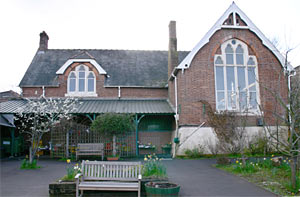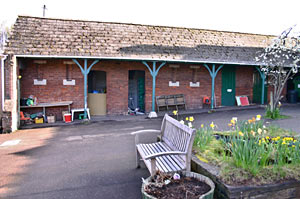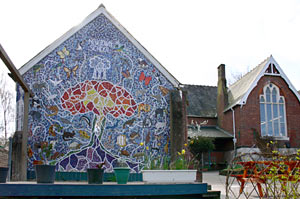
Newtown Primary School
The growth of Exeter in the 19th century, along with the 1870 Education Act led to the local School Board planning to build four Board Schools in Exeter. They were to be in Exe Island, St James' Road, Mary Arches and Newtown.Land on Summerland fields had been leased in 1629 for a period of 2,000 years, to provide income from rent, for a charity set up by Christopher Sandford. Some 250 years later, on 22 April 1873, the Board of Charity Commissioners authorised the trustees of the old charity to sell a parcel of this land, for £400, to the School Board.
The School Board invited Pearson Barry Hayward, the son of John Hayward, architect of the Royal Albert Memorial Museum and St Luke's College to submit plans for the new school. The design he came up with is very reminiscent of his father's Victorian Gothic creations. The Exeter Flying Post reported in August 1874:
"Payments have been made to Messrs Stephen and Son, on account of building Exe Island School, £400 and Newtown School, £400; to Mr John Kenshole in respect of Mary Arches School, £520."
Soon, two buildings were erected on the Clifton Road site at a cost of £2,037. The Infants' School building housed some 200 children, in a classroom and a large room. The second building for the Girls' School had a large L-shaped room, and a classroom for 150 children. The classrooms were arranged in stepped galleries so that the teacher would maintain a clear view of the pupils at their desks.
Heating in the new school was with open coal fires, which over time were replaced with cast iron stoves. Wall mounted gas heating was added in the 1950's, but it wasn't until 1966 that the last of the coke fire stove was replaced with gas convector heating. It was in 1934 that the original gas lighting was replaced with electric lights.
Education for the poor
The 12 girls to the new school were welcomed on the 8th June 1874 by Miss A Gill and Miss Emily Strowbridge. By January 1875, there were 62 children gaining an education. Initially, attendance was plagued by absenteeism - many children were poorly clothed and would not attend when it was wet or cold because of lack of shoes, or because they had important household chores to attend to, such as caring for younger brothers and sisters. Many of the children were from the workhouse off Gladstone Road and would be accompanied to school, wearing regulation hobnail boots, and dressed in navy and black. The workhouse remained until 1929, when it became a hospital.
In 1879, Miss Marianne Austin joined the school as headmistress - she would remain until 1916, a period of 37 years.
In 1889 Newtown Boys' School was added to the site at a cost of £2,697 9s plus £135 10s for desks. The first headmaster was Charles Bryan who served from 1890 to 1905. The Boys' School opened on 14th April 1890 with an intake of 55 boys. Attendance was poor at first, for many of the same reasons as the girls, but by 1893 there were 277 boys registered.
The First World War saw Mr Lawrence, of the Boy's School, leave for the front and other teachers moved to fill vacancies elsewhere. Classes were reorganised and merged. Mr Lawrence returned at the Armistice and continued teaching until 1946. After the war life returned to normal for the school. In 1930, the Girls' and Infants were amalgamated and in 1937 the school renamed Newtown Junior Girls and Infants. It was at this time that children over 10 transferred to the emerging senior schools, such as Ladysmith School.
The school takes a hit
The Second World War would prove to be traumatic for Newtown School. An influx of evacuees had to be accommodated, teachers had to attend firewatch duty, and in May 1940, the school was taken over for use by the armed forces - luckily this was for only five days. The first air raid was in December 1940 when the children were quickly evacuated to bomb shelters in the area. However, the raid of 4th May 1942 saw a direct hit on the school, badly damaging several buildings. Repairs were made, but the infant block was a total loss.
In 1951, Newtown had a winning football team coached by Mr Champion in Belmont Park - they beat John Stocker School 1-0 in the final. In 1973 Newtown became a First School when the city adopted the middle school system. By 1990 the school had a Diagnostic and Assessment Unit for children with special needs which became one of the leading units in the county. It is now known as a Speech and Language Centre.
In March 1991, the headmistress Joy Wickers arranged for parents, teachers and pupils to create an environmental garden. She said "We will have a compost area, butterfly area, bird boxes and herb garden and plants that attract wildlife well. It is an on-going nature project which we feel will be of great benefit to the children for generations to come." Sponsors were found for the project from local companies including Otter Nurseries, B&Q, St Bridget Nurseries, Powderham Sawmills and Newton Leisure Club.
And so to the present - in 2005, Newtown School became a primary school once again, under the city wide change to a more conventional primary, secondary system. Newtown has become a popular school, with many children coming from well beyond its catchment area and continues to go from strength to strength.
Source - Willingly to School by J Sturman and S Barnes, Newtown School Website
 The front of
Newtown School.
The front of
Newtown School.
 One of the original buildings of the
school.
One of the original buildings of the
school.
 The
mosaic at Newtown School.
The
mosaic at Newtown School.
│ Top of Page │